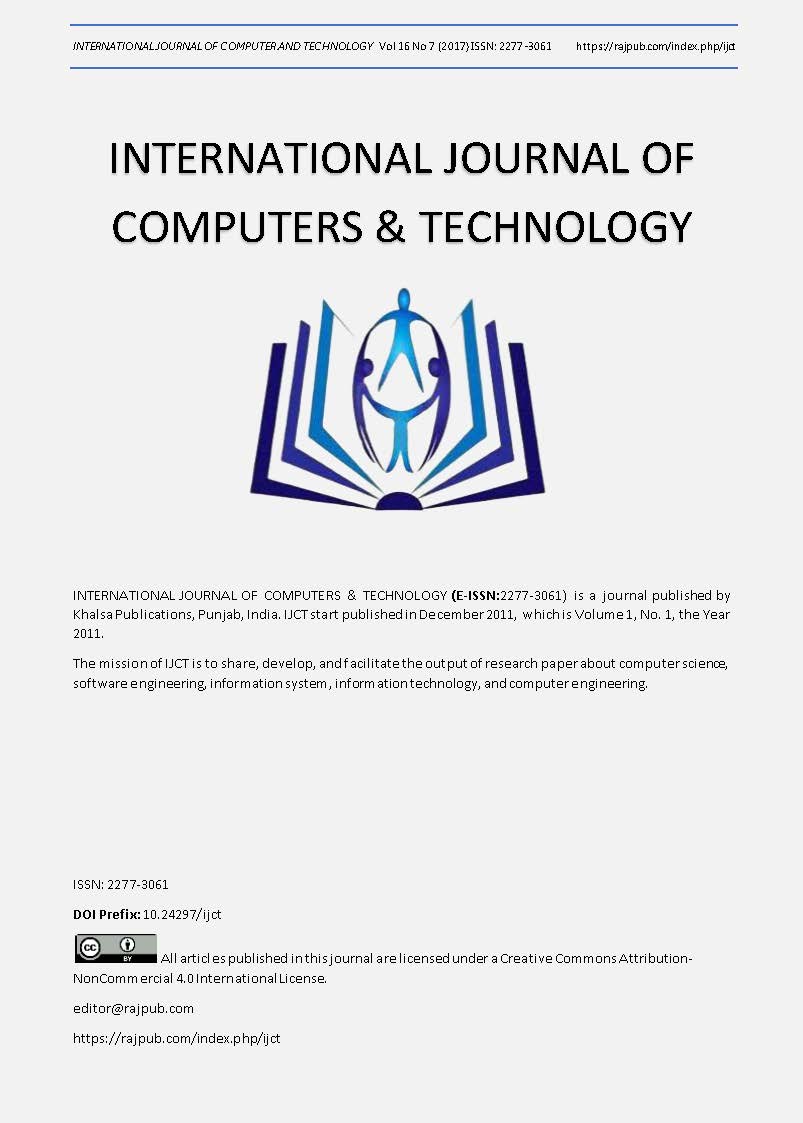A NOVEL APPROACH OF CLUSTERING FOR ENHANCED LIFETIME IN WIRELESS SENSOR NETWORK
DOI:
https://doi.org/10.24297/ijct.v16i7.6454Keywords:
Wireless Sensor Network, Energy saving, Protocol, Cluster Head, Node, WSNAbstract
Wireless sensor network has revolutionized the way computing and software services are delivered to the clients on demand. Our research work proposed a new method for cluster head selection having less computational complexity. It was also found that the modified approach has improved performance to that of the other clustering approaches. The cluster head election mechanism will include various parameters like maximum residual energy of a node, minimum separation distance and minimum distance to the mobile node. Each CH will create a TDMA schedule for the member nodes to transmit the data. Nodes will have various level of power for signal amplification. The three levels of power are used for amplifying the signal. As the member node will send only its own data to the cluster head, the power level of the member node is set to low. The cluster head will send the data of the whole cluster to the mobile node, therefore the power level of the cluster head is set to medium. High power level is used for mobile node which will send the data of the complete sector to the base station. Using low energy level for intra cluster transmissions (within the cluster) with respect to cluster head to mobile node transmission leads in saving much amount of energy. Moreover, multi-power levels also reduce the packet drop ratio, collisions and/ or interference for other signals. It was found that the proposed algorithm gives a much improved network lifetime as compared to existing work. Based on our model, multiple experiments have been conducted using different values of initial energy.
Downloads
References
Y. Xiuwu, Fan Feisheng Zhou Lixing and Z. Feng, "WSN Monitoring Area Partition Clustering Routing Algorithm for Energy-Balanced," IEEE, pp. 80-84, 2016.
Dan Liu, Qian Zhou, Zhi Zhang and Baoling Liu, "Cluster-Based Energy-Efï¬cient Transmission Using a New Hybrid Compressed Sensing in WSN," IEEE, 2016.
Li Li , Zhu Yafei, Duan Xiaoyi and Shi Guozhen, "Research on Secure Communication Scheme of Clustered WSN Based on Dynamic Key," IEEE, pp. 833-837, 2016.
S. Bera, S. Misra, Sanku Kumar Roy and Mohammad S. Obaidat, "Soft-WSN: Software-Deï¬ned WSN Management System for IoT Applications," IEEE, pp. 1-8, 2016.
N. A. M. Alduais, J. Abdullah, J. Abdullah, A. Jamil and L. Audah, "An Efficient Data Collection and Dissemination for IOT based WSN," IEEE, 2016.
O. Singh, V. Rishiwal and M. Yadav, "Energy Trends of Routing Protocols for H-WSN," IEEE, 2016.
R. Kumari and . P. Nand , "Performance Comparison of various Routing Protocols in WSN and WBAN," IEEE, pp. 427-431, 2016.
Hector Kaschel and ohanna Ortega , "Energy efficiency in routing protocols applied to WSN," IEEE, 2016.
Asdianur Hadi and Ida Wahidah, "Delay Estimation using Compressive Sensing on WSN IEEE 802.15.4," IEEE, pp. 192-197, 2016.
Mohd Zaki Shahabuddin, Halabi Hasbullah and Izzatdin A Aziz, "eliminary Framework of Topology Control Algorithm Ahieve Node™s Energy Efficiency," IEEE, pp. 259-263, 2016.
M. Shaiful Azrin , Md Alimon, L.M. Kamarudin and Goh Chew Cheik, "Connecting WSN to Google Fusion Tables, a REST Database for Data Storage," IEEE, pp. 342-347, 2016.
Abhaykumar L. Gupta and Narendra Shekokar , "A Novel Approach to Improve Network Lifetime in WSN by Energy Efficient Packet Optimization," IEEE, 2016.
B. Bengherbia, S. Chadli, M. Ould Zmirli and A. Toubal, "A MicroBlaze Based WSN Sink Node Using XBee Transceiver," IEEE, pp. 831-834, 2016.
Gagandeep Kaur, Deepali and Rekha Kalra, "Improvement and Analys Security of WSN From Passive Attack," IEEE, pp. 4520-425, 2016.
M. Wu, H. Liu and Q. Min, "Lifetime Enhancement by Cluster Head Evolutionary Energy Efficient Routing Model for WSN," IEEE, pp. 545-548, 2016.
Roman Lara-Cueva, Rodolfo Gordillo, Liliana Valencia and Diego S. Ben, "Determining the Main CSMA Parameters for Adequate Performance of WSN for Real-time Volcano Monitoring System Applications," IEEE, pp. 1-9, 2016.
Sanaa. S. Abd El dayem and M. R. M. Rizk , "An Efficient Authentication Protocol and Key Establishment in Dynamic WSN," IEEE, pp. 178-182, 2016.
Carlos Valdivieso, Francisco Novillo, Jorge Gomez and Daniel Dik, "Centralized Channel Assignment Algorithm for WSN Based on Simulated Annealing in Dense Urban Scenarios," IEEE, 2016.
Jai Prakash Prasad, and Suresh Chandra Mohan , "Global Wireless Tele-Communication WSN s Architecture Using N-Tier Spherical GRID Routing," IEEE, pp. 108-112, 2016.
Swathi N, Santosh Kumar S, R. Sunil Kumar KN, and Rajendra Prasad P , "Zone Based Hierarchical Energy Efficient Clustering Scheme for WSN," IEEE, pp. 136-140, 2016.
Praveen Kumar K.V, , M.K Banga,, Udaya Rani V, B.M Thippeswamy, and K.R Venugopal , "EBDRA: Energy Balanced Dynamic cluster Routing Approach for WSN," IEEE, pp. 141-145, 2016.
Pavithra.H, , Shivashankar and Poornima G.R, "An Efficient Mobile Sink path Selection approach for WSN s," IEEE, pp. 151-155, 2016.









